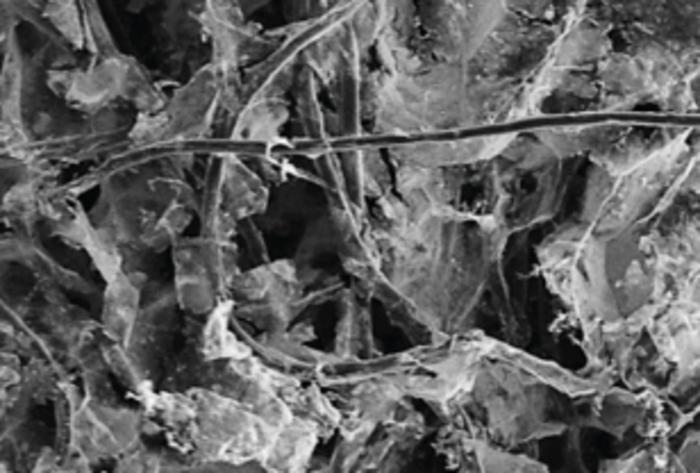
In a groundbreaking development in air filtration technology, researchers from Drexel University have unveiled the potential of MXene-coated textiles to enhance air filters significantly. As urban air quality continues to deteriorate due to emissions from vehicles and factories, the need for effective air filtration becomes increasingly critical. The interdisciplinary team from Drexel’s College of Engineering has pioneered a method that leverages MXene nanomaterials to revolutionize the effectiveness of commonplace filters, rendering them not only more efficient but also more sustainable.
MXenes, a class of two-dimensional materials discovered by Drexel researchers in 2011, have garnered significant attention due to their remarkable properties, including electrical conductivity and mechanical strength. Their application in air filtration has been an area of keen interest as researchers strive to find solutions to capture the smallest airborne pollutants. The recent study highlights the successful integration of MXene coatings onto non-woven polyester textiles, a material typically regarded as low-cost and low-efficiency in terms of filtration capability. However, when coated with MXene, these textiles exhibit an extraordinary filtration efficiency, capable of capturing particles as small as 15 nanometers.
Current air filters often struggle with particles below 100 nanometers, including many harmful emissions generated by industrial activities and vehicles. This limitation has prompted a search for solutions that can augment existing filtration systems. The research team, comprising experts in materials science and engineering, conducted experiments that showcased how the application of a thin layer of titanium carbide MXene transforms standard filters into highly efficient tools for air purification. The ability to capture such fine particles is vital, considering that this size range encompasses not just pollutants but potentially harmful microorganisms as well.
The study’s findings, published in the Journal of Carbon Research, offer promising insights into the future of filtration technology. The researchers reported that polyester textiles coated with MXene achieved approximately 90% filtration efficiency against nanoparticles as small as 15-30 nanometers. This achievement is particularly significant for environments plagued by industrial pollution, where the presence of ultrafine particles poses serious health risks. The simplicity of the coating process further enhances the appeal of this solution, making it a viable option for integration into existing air filter production systems.
One interesting aspect of the research involved pretreating the textile filters with magnesium salt before applying the MXene coating. This step was found to improve the adhesion and performance of the coating, contributing an additional 25% filtration efficiency. By activating the surface of the MXene, the researchers were able to enhance the uniform dispersion of the material, creating a complex matrix that traps particles more effectively. This innovative approach highlights the significance of surface chemistry in optimizing filter performance, setting the stage for future advancements.
In their testing, the researchers explored various configurations of the filters, including untreated samples, MXene-coated only, and MXene-coated alongside magnesium ion treatment. The results revealed a clear superiority of the latter in capturing a wide range of particle sizes, demonstrating the potential of this novel filtration method in real-world applications. The implications of these findings are enormous, with the prospect of incorporating MXene-coated filters into HVAC systems or other air purification devices promising improved air quality in both residential and commercial settings.
Moreover, the electrically conductive properties of MXenes could pave the way for self-cleaning filters. By applying an electric current to a MXene-coated filter, the material’s temperature can be raised, enabling it to burn away trapped particles and debris. This self-cleaning mechanism not only ensures the longevity of the filter but also maintains its high efficiency over extended periods, which is crucial for practical applications in air purification.
As the environmental challenges posed by air pollution increase, so does the urgency for innovative solutions. The ongoing research at Drexel University promises a new era in air filtration technology, where MXene coatings could usher in smarter, more effective air cleaning systems. The versatility of MXenes, now demonstrated through their effectiveness in filtration, points to their potential for numerous applications across various industries, from environmental engineering to healthcare.
In addition to their implications for air quality, this research opens avenues for exploring how MXenes can be utilized in other filtration contexts, such as water treatment and virus removal in medical settings. The multifunctionality of these materials positions them as pivotal players in the quest for cleaner air and safer environments, underscoring the necessity for further exploration and optimization of MXene technology.
The collaborative effort between experienced researchers and eager students in this study exemplifies the spirit of innovation within academia. With mentorship from seasoned professionals like Dr. Michael Waring and Dr. Yury Gogotsi, the next generation of engineers is well-equipped to tackle the pressing challenges of our time, honing their skills in materials science while contributing to tangible advancements in public health.
Today’s announcement of the capabilities of MXene-coated textiles in air filtration heralds new methodologies that could potentially revolutionize the way we approach pollution control. As these materials become more accessible and manufacturing processes improve, we may well witness a significant transformation in air quality management strategies worldwide. The journey of discovery continues, with researchers dedicated to pushing the frontiers of science and engineering in search of sustainable solutions for a cleaner future.
Subject of Research: MXene-coated textiles for air filtration
Article Title: Nanoparticle Air Filtration Using MXene-Coated Textiles
News Publication Date: 12-Feb-2025
Web References: Link to the study
References: DOI link
Image Credits: Credit: Drexel University
Keywords
Tags: advanced air filtration technologycapturing airborne pollutantsDrexel University research breakthroughsenhancing filtration efficiencyindustrial emissions reductioninnovative textile coatingsMXene-coated air filtersnanomaterials in air filtrationnon-woven polyester textilessustainable air filtration solutionstwo-dimensional materials applicationurban air quality improvement





